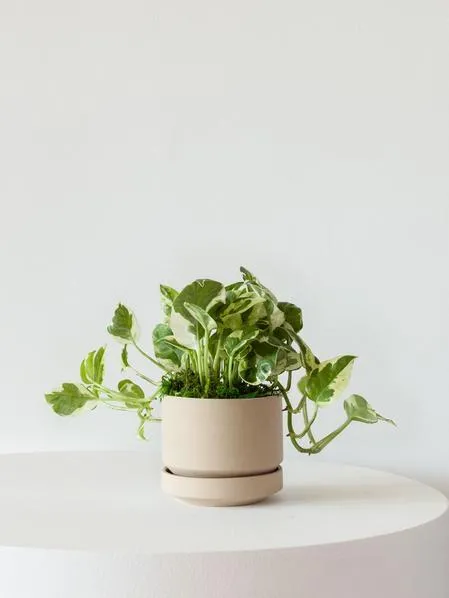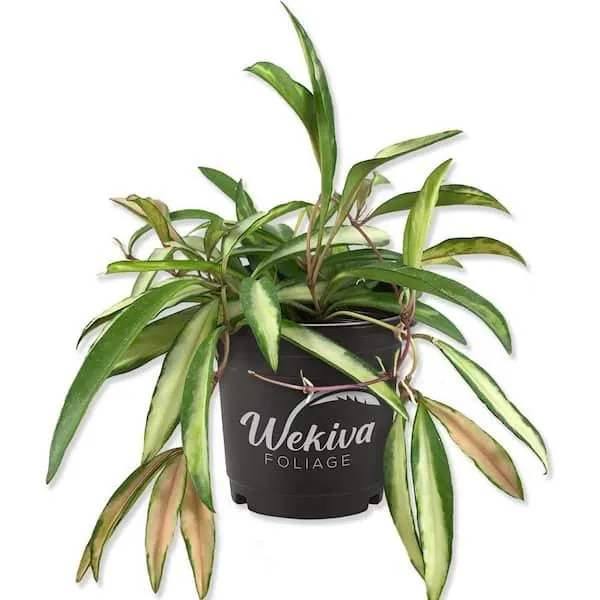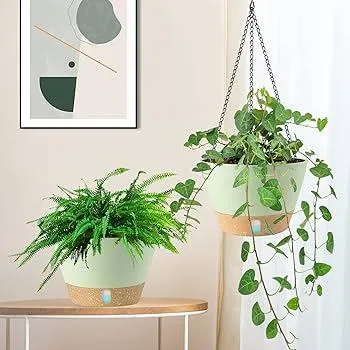Plants That Will Hang Down and Look Gorgeous: A Guide to Cascading Houseplants
If you’re looking to add some visual interest vertically in your home, plants that cascade over the sides of their pots are a stunning option. From my experience, dangling foliage can really elevate the look of a space. In this article, I’ll share some of the best selections for plants that will trail beautifully, along with tips on care so they’ll thrive for years to come. Let’s get started!
Golden Pothos
Golden pothos has gotta be one of the most forgiving trailing plants out there. Kind of like the basic jeans of the plant world – it goes with everything! Its heart-shaped leaves come in a lovely shade of light green with splotches of yellow. Pothos can handle low to medium light and doesn’t mind the occasional dry spell between waterings. You guessed it – it’s practically impossible to kill. I often recommend this one to plant newbies. You really can’t go wrong with a pothos to start your cascading plant collection.
Swedish Ivy
Swedish ivy goes by another name – needlepoint ivy. And it totally lives up to that name with its super fine, trailing leaves. The foliage has a nice felted texture and comes in shades of dark green sometimes splashed with cream or yellow. It thrives in medium to bright light and keeps a more compact shape compared to other trailing plants. Swedish ivy handles lower light well too, though the colors may be less vibrant. It’s sort of the opposite of pothos – a bit harder to care for but the trade off is those fabulous narrow leaves.
Wandering Jew
OK, I know the name of this one isn’t exactly PC these days but it is what it is, folks. Wandering Jew has these cute little oval-shaped green or purple leaves along its vines. It likes decent light and mild to warm conditions. The trick with Wandering Jew is not to overwater – let the soil dry out between waterings. It will definitely tell you if it’s not happy by curling those pretty leaves. But when treated right, it will trail beautifully. You can often find this one in bold shapes like baskets for a really noticeable impact.
English Ivy
No surprises here – English ivy is the classic cascading plant that can grow forever if you let it. Its small, deep green leaves have a glossy sheen. Ivy thrives outdoors in zones 5-9 but also makes a fabulous houseplant. It demands bright light to keep it bushy and full. English ivy can tolerate low temperatures too, so it’s perfect for cooler homes. The vines root wherever the stems touch the soil, so be prepared for it to get aggressively long. Still, it’s impossible to deny how elegant the trailing foliage looks spilling over the sides of containers.

Spider Plant
With its long, arching grass-like leaves sporting tiny white-striped “spiderettes,” spider plant just has such a cool, retro vibe. Its leaves are thick and leathery so it’s pretty low maintenance – content to dry out a bit between drinks. Spider plant thrives in medium to low light. Give it bright, indirect sunlight and it will reward you with plantlets or “spiderettes” along the stem that can be removed and replanted for new spider plants. This is definitely one of those plants that go the distance thanks to its pups. Great for offices and low-care spaces.
Philodendron
Now we’re talking about another genus with loads of great trailing options – philodendron. Some top picks include ‘Brazil’ philodendron which has these thick, waxy dark green leaves with yellow markings. ‘Heartleaf’ philodendron is another reliable choice with its deeply lobed foliage. Both enjoy medium to bright indirect light. Philodendrons appreciate high humidity but will survive in average home conditions too. They climb or climb by clinging to surfaces with aerial roots so they make awesome hanging baskets when given a moss pole or trellis to ramble upon. Philodendrons pretty much rule the trailing plant world, if you ask me.
Chinese Evergreen
Talk about a stunner – Chinese evergreen comes through with these gorgeous, thick leaves patterned in shades of dark green, cream and pink. It prefers medium to low light. The leaves are pretty hardy but can brown if overwatered. Allow the soil to dry out between watering sessions for the Chinese evergreen. It grows slowly but will reward your patience with such lush, full growth. This one’s perfect for showing off due to its fab leaves. Mix it into a hanging planter for a real head-turner on your wall or staircase.
Tips For Caring For Trailing Plants
No matter which cascade-happy varieties you choose, there are some basic best practices for keeping them looking gorge and thriving:
- Bright, indirect light: Most trailing plants love eastern or western exposures where they get plenty of sun but aren’t scorched in the hot afternoon rays.
- Good drainage: Use a well-draining potting mix and don’t let water pool in the saucers or stems will rot. Terracotta is an ideal pot material.
- Stake or hang: Give long vines something sturdy like a moss pole or trellis to scramble up so they don’t just pile on the floor. Hanging baskets are ideal.
- Regular water: When the soil is dry a inch or two down, give plants a thorough drink. Use room temp water and not ice cold straight from the tap.
- Fertilize occasionally: Once a month in the growing season, feed hanging plants diluted liquid houseplant fertilizer per package instructions.
- Prune judiciously: Remove straggly or leggy growth to keep plants bushy. Cut back by 1/3 in spring for fuller regrowth.
Some Real-Life Cascading Plant Situations
Now lemme tell you about some cascading plant combos I’ve got goin’ on personally:

In my kitchen, I’ve got a rope hanging planter stuffed with golden pothos, spider plant and philodendron. It trails down right by the window over the sink. It adds such a nice tropical vibe while I’m doing dishes. The vines have gotten long – I kinda like that jungle effect! But I’ll have to prune it back soon before it touches the counter.
Outside on my front porch, I tried english ivy in a hanging basket last year. Big mistake, bro! That sucker took over everything like kudzu. It was lush, sure, but also a total weed. So I yanked it out and swapped in some sweet wandering jew instead. Much happier with how it’s kept its shape without trying to swallow the porch.
In my home office, I’ve got a little ledge under the window that’s perfect for a Swedish ivy. It loves the medium light there and idly trails down in its terra cotta pot, framing my computer screen. Such an easy, low-maintenance plant to jazz things up. Hardly ever needs watering too, which is clutch when I’m deep in work mode.
So in summary, cascading plants can seriously transform a space whether indoors or out. But they all have different light and care needs – so pay attention to what truly works best depending on your conditions. With a little TLC, these beauts will thrive for years and continue to hang around gorgeously. Cool, huh?
Have Additional Questions?
I hope this guide has answered your questions about some top picks for plants that will cascade beautifully! If you need any other tips, feel free to hit me up. It’s been so dope sharing my plant parent wisdom. Wishing you lush success with your new trailing foliage friends. Keep on growin’, my plant peeps!

Factors to Consider When Choosing the Best Indoor Plants
| Plant | Light Needs | Watering | Size | Care Level |
|---|---|---|---|---|
| Pothos | Low | Let dry between waterings | Trails up to 8 feet | Easy |
| Snake plant | Low | Allow soil to dry out between waterings | Up to 3 feet tall | Very easy |
| Chinese evergreen | Medium | Water when top inch of soil is dry | Up to 3 feet tall and wide | Moderate |
| ZZ plant | Low to medium | Let soil dry slightly between waterings | Up to 4 feet tall | Very easy |
| Peace lily | Medium | Water when top inch of soil is dry | Up to 2 feet tall | Moderate |
FAQ
-
What kinds of plants grow by trailing downwards?
Some common varieties that dangle from heights include english ivy, wandering jew, pothos, grapes, and wisteria. They basically use climbing stems or vines to hug walls, travel along fences, or climb trees.
-
How do trailing plants attach themselves?
Trailing plants use different methods to cling on. Grapevines and ivy employ tiny suckers on their stems to stick to surfaces. Wisteria and morning glory wrap their long, twining vines tightly around supports. Lesser known creepers use tendrils or aerial roots for anchorage. I guess mother nature came up with amazing solutions!
-
What features allow plants to trail effectively?
According to botanists, trailing plants possess special traits that help them dangle. Their stems are typically weak and flexible. The internodes (zones between leaves) are lengthy to allow swinging.Specialized structures like holding disks or spiral twisting aid gripping onto objects. Their growth habit prioritizes vertical extension over lateral branching too. These properties altogether permit the plants to sort of “fall with style.”
-
How do gardeners use trailing plants decoratively?
Trailing plants offer wonderful ways to beautify gardens. Landscapers hang varieties from baskets, arrange them spilling from containers, or train them onto frames, trellises or pergolas. This produces stunning visual effects whether the goal is covering an ugly area or adding an natural element to the scenery. Growers also combine trailing kinds along steps or retaining walls for an incredibly charming appearance. Their informal texture contrasts well with more structured designs.
-
Are there any disadvantages to trailing plants?
While cascade plants uplift landscapes, they certainly aren’t perfect. Their relaxed growth can make plants appear messy unless pruned or controlled. Overly rampant varieties may basically take over! This could potentially harm other plants buried underneath. Additionally, some aggressive creepers pose invasive threats outdoors. Wisteria comes to mind here – it easily overwhelms arbors given half a chance! I guess even mother nature makes a few mistakes.

-
What kinds of support do trailing plants require?
Fortrailing plants to do their thing properly, they need guidance. Gardeners supply them with features to cling onto like trellises, fences, wiring, arbors or pergolas. Stakes help direct vertical stems upwards at first too. In some cases, gardeners may tie or train plants manually to their intended paths. The strength and structure of the aid depends on the individual species or cultivar. Perhapsexperimenting could find which best matches each creeper’s habits!
-
Should all trailing plants be grown the same way?
Interestingly, the culture for trailing plants varies significantly depending on the variety. While ivy thrives draped loosely, wisteria must be trained vertically as a young plant. Grapevines achieve balanced harvests with a specific pruning strategy too. Certain climbers especially prefer damp, nutrient-wealthy soil. And some fast growers may warrant staking more than dainty trailers. In conclusion, unique needs necessitate tailoring techniques for specimen. One size usually doesn’t fit all where mother nature molded diversity!
